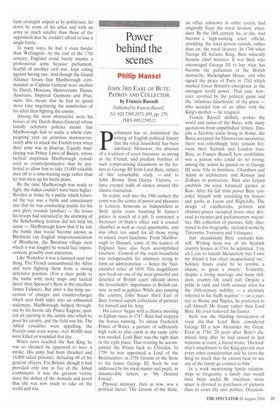Power behind the scenes
Philip Manse!
JOHN 3RD EARL OF Bum: PATRON AND COLLECTOR by Francis Russell Published by Francis Russell, Tel: 020 7389 2073, £95, pp. 279, ISBN 0951259512 parliament has so dominated the writing of English political history that the royal household has been sidelined. Moreover, the absence of a tradition of court literature as strong as the French, and prudent bonfires of such compromising documents as the letters to George III from Lord Bute, subject of this remarkable study — and to John Brown from Queen Victoria — have erected walls of silence around this elusive institution.
In reality, well into the 19th century the court was the centre of power and pleasure in London. Someone as independent as Swift spent years haunting St James's palace in search of a job. It contained a Secretary of State's office and a council chamber as well as royal apartments, and was often too small for all those trying to attend court functions. From Marlborough to Disraeli, some of the leaders of England have also been accomplished courtiers. Control of the royal household was indispensable for ministers trying to form an adminstration — hence the 'bedchamber crisis' of 1839. This magnificent new book on one of the most powerful and detested of British court officials shows the household's importance in British culture as well as politics. While also running the country, John Stuart third Earl of Bute formed superb collections of pictures for himself and his king.
His career began with a chance meeting at Egham races in 1747. Rain had stopped the horses running. To amuse Frederick Prince of Wales, a partner of sufficiently high rank to play cards at the same table was needed. Lord Bute was the right man in the right place. That evening he accompanied the Prince back to Cliveden. In 1750 he was appointed a Lord of the Bedchamber. in 1756 Groom of the Stole to the future George III. Soon he was addressed by his royal master and pupil, in innumerable letters, as 'My Dearest Friend'.
Physical intimacy, then as now, was a political factor. The Groom of the Stole, an office unknown in other courts, had originally been the royal lavatory attendant. By the 18th century he, or she, had become a high-ranking court official, attending the royal person outside, rather than on, the royal lavatory. In 1760 when George III became King, Bute naturally became chief minister. It was Bute who encouraged George III to buy what has become the palladium of the British monarchy, Buckingham House, and who signed the peace of Paris in 1763 which marked Great Britain's emergence as the strongest world power. That year, however, revolted by the political game and the 'infamous falsehoods' of the press — who accused him of an affair with the King's mother — he resigned. Francis Russell skilfully evokes the world and tastes of the Butes, with many quotations from unpublished letters. Despite a Jacobite uncle living in Rome. the Butes accepted the Hanoverian succession; there was refreshingly little tension between their Scottish and London lives. Bute, as Francis Russell here establishes, was a patron who could do no wrong: among the artists he passed on to George III were Vile in furniture, Chambers and Adam in architecture and Ramsay and Zoffany in portraiture. Bute also helped establish the royal botanical garden at Kew. After his fall from power Bute consoled himself with extending his houses and parks at Luton and Highcliffe. The design of candlesticks, pelmets and chimney-pieces occupied hours once devoted to treaties and parliamentary majorities. His collection of pictures, fully illustrated in this biography, included works by Tintoretto, Veronese and Velasquez. Just occasionally Bute unmasks himself. Writing from one of his Scottish country houses in 1744, he admitted, 'I try all I can to banish Melancholy but I own my friend it has often incapacitated me.' Solitary hours could be 'so terrible a chasm, so great a misery'. Evidently, despite a loving marriage and many children, country life could pall. Despite a pride in rank and birth unusual even for the 18th-century nobility — a secretary referred to his 'huffy manner' — on a journey to Rome and Naples, he preferred to call himself Mr Stuart rather than Lord Bute. He even removed his Garter.
Such was the blinding intoxication of royal life that Lord Bute considered George III a new Alexander the Great. Even in 1784, 20 years after Bute's dismissal, long after he had ceased to feel welcome at court, a friend wrote. 'His lordship's attachment to the King prevails over every other consideration and he loves the King so much that he cannot bear to see any of the family go counter to him.' In a work mentioning family relationships so frequently, a family tree would have been useful. By intention, more space is devoted to purchases of pictures than to court life and politics. Occasion
ally the formality of 18th-century prose invades that of Lord Bute's biographer, as in the remark that the `loving friendship' between Lord Bute and Augusta Princess of Wales, mother of George III, 'rested on bonds far more stable than those of the flesh' — as if such bonds are necessarily more unstable than others. Nevertheless, it is a brilliant portrait of the inner workings of British politics and culture at a time when, as the Countess of Northumberland declared to James Boswell, the court was 'the best coffee house in town'.



























































 Previous page
Previous page